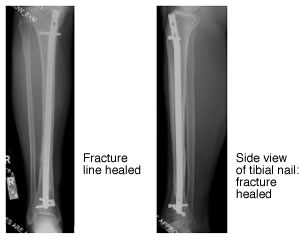In the Hospital, What Now?
Together, you and your orthopaedic surgeon will decide on a course of aftercare that's most appropriate for you. The full length of your care may span several months. Rehabilitation will begin in the hospital and continue with outpatient physical therapy sessions, as well as at home. Understanding your care may help you feel more comfortable throughout the healing process.
How do I care for the new incision sites?
At first, a hospital medical professional will take care of your incision sites. Like any other wound, they must be cared for every day to avoid complications that may include infection. As your health allows, you will probably learn how to care for the incision sites yourself.
The steps required to care for your wounds at home are described on page 3 within the section "At Home. Where Do I Go from Here?"

Why take additional X-rays?
Following surgery, your surgeon will take X-rays every few weeks to confirm that the fracture is healing appropriately. Keep in mind that everyone heals differently. You will heal at your own pace based upon a number of factors that your surgeon can discuss with you. Your surgeon will keep you informed about your progress each step of the way.
How does physical therapy help me heal?
Since motion and muscle strength play an important role in fracture healing, the right exercises can significantly aid in your recovery. Of course, the fracture itself may hinder the use of your injured limb. Your doctor's choice of an intramedullary nail gives you the potential to begin moving earlier than treatment with an external cast or brace.
A physical therapist will work closely with you to select the most appropriate treatment and exercises to help you restore your range of motion and rebuild muscle strength.
<< Previous Page || Next Page >>